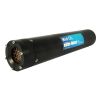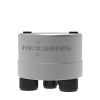Pro-Oceanus Solu-Blu Dissolved CH4 Probe
Features
- Provides continuous 24/7 dissolved CH4 monitoring
- Fully temperature and pressure compensated
- Ideal for groundwater baseline monitoring or lab fermentation studies
- Expedited repair and warranty service
- Lifetime technical support
- More
Overview
The Solu-Blu dissolved CH4 probe can be used for long-term continuous in-situ monitoring to provide dissolved methane data for applications such as groundwater baseline monitoring and laboratory fermentation studies. The probe provides fully temperature and pressure-compensated data. Flow-through and in-line adapters are also available for simple and effective industrial solutions.
Mechanics
The measurement of a gas dissolved in a liquid is facilitated by a semi-permeable membrane that allows gases to transfer from water into a gas head space where the measurement is made. The simple yet rugged sensor allows for the monitoring of methane in a range of environments and liquids. The probe is configured for multiple data output formats to allow for rapid integration into most platforms for data transmission and collection with minimal time and effort.
| Sensor Performance | |
|---|---|
| CH4 Measurement Ranges | 0-30 mg/L 0-3 mg/L 0-300 μg/L |
| Accuracy | |
| CH4 | ± 3% of max range |
| TDGP | ± 0.1% |
| Temperature | ± 0.5º C |
| Equilibration rate (t63): | ~10 minutes |
| TDGP | 10 minutes |
| Resolution pCO2 | 0.1% of max range |
| Physical | |
|---|---|
| Length | 20 cm (8 in) 26 cm with connector |
| Diameter | 5 cm (2 in) |
| Weight | 0.28 kg (0.6 lbs) |
| Housing Material | Acetal Plastic |
| Depth Rating | 0 - 50 meters |
| Water Temperature | -2º to 40º C |
| Electrical | |
|---|---|
| Input voltage | digital: 6-24 VDC analog: 12-24 VDC |
| Power consumption | 0.45 W (35 mA @ 12 V) |
| Data output | RS-232, ASCII format 0-5 V or 4-20 mA |
| Sample rate | 1 second |
In The News
In the Right Place All the Time: Greenhouse Gas Research and NTL-LTER
While researchers all over the globe have been studying greenhouse gases, there are still some areas in the field that have not received as much attention as they deserve. Emily Stanley, professor in the department of integrative biology at the University of Wisconsin and principal investigator for North Temperate Lakes Long Term Ecological Research (NTL-LTER), has spent a significant part of her career exploring a few of them. “Clearly we have a problem with greenhouse gases. What people may not realize is that streams and lakes are hotspots of global methane and CO2. Understanding greenhouse gas dynamics in these systems is important because they are vents all over the world and they are not insignificant,” said Stanley.
Read MoreMonitoring Mariculture in the Gulf of Alaska
The mariculture industry in the Gulf of Alaska has been steadily growing in recent years, guided by ongoing research to help refine farm location and cultivation practices. A subset of aquaculture, mariculture focuses on rearing organisms in the open ocean. In Alaska, finfish farming is illegal, so most farms cultivate kelp, oysters, or a combination of the two. These small, locally operated farms started popping up in the Gulf of Alaska in the early 1990s, when shellfish farming first became legal. Kelp farming did not begin to catch on in the state until 2016. Many of the coastal areas that have grown interested in mariculture are historically commercial fishing communities.
Read MoreSupplying Seattle’s Drinking Water: Using Data Buoys to Monitor the Cedar River Municipal Watershed
Providing clean, safe, and reliable drinking water for the 1.6 million people in the greater Seattle area is a top priority for Seattle Public Utilities (SPU). With limited water supplies, SPU dedicates considerable resources to maintain its watersheds and mountain reservoirs. About 70 percent of Seattle Water comes from the Cedar River Municipal Watershed , and the other 30 percent comes from the South Fork Tolt River Watershed . [caption id="attachment_39574" align="alignnone" width="940"] Data buoy in Chester Morse Lake . (Credit: Kevin Johnson / Seattle Public Utilities) [/caption] Jamie Thompson, a fisheries biologist at SPU, monitors aquatic ecosystems centered on fish listed under the U.S. Endangered Species Act (ESA).
Read More
















